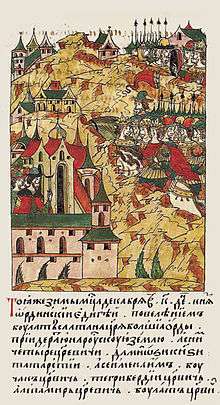Edigu


Edigu (or Edigey) (also İdegäy or Edege Mangit) (1352–1419) was a Mongol Muslim Emir of the White Horde who founded a new political entity, which came to be known as the Nogai Horde.
Edigu was from the Crimean Manghud tribe, the son of Baltychak, a Mongol noble who was defeated and killed by Khan Tokhtamysh of the Golden Horde in 1378. He gained fame as a highly successful general of Tokhtamysh before turning the arms against his master. By 1396, he was a sovereign ruler of a large area stretching between the Volga and Ural (known locally as Yayyk) rivers, which would later be called the Nogai Horde.
In 1397 Edigu allied himself with Timur-Qutlugh and was appointed General and commander-in-chief of the Golden Horde armies. In 1399 he inflicted a crushing defeat on Tokhtamysh and Vytautas of Lithuania at the Vorskla River. Thereupon he managed to unite under his rule all Jochi's lands, albeit for the last time in history.
In 1406 he located his old enemy Tokhtamysh in Siberia. Edigu's agents killed Tokhtamysh. The following year he raided Volga Bulgaria. In 1408, he staged a destructive Tatar invasion of Russia, which hadn't paid the tribute due to the horde for several decades. Edigu burnt Nizhny Novgorod, Gorodets, Rostov, and many other towns but failed to take Moscow, though he had still burnt it.
Two years later Edigu was dethroned in the Golden Horde and had to seek refuge in Khwarezm. Shah Rukh of Herat expelled him back to Sarai, where he was assassinated by one of Tokhtamysh's sons in 1419. Edigu's dynasty in the Nogai Horde continued for about two centuries, until his last descendants moved to Moscow, where they took baptism and became known as Princes Urusov and Yusupov.
References
This article incorporates material from the public domain 1906 Brockhaus and Efron Encyclopedic Dictionary.
|